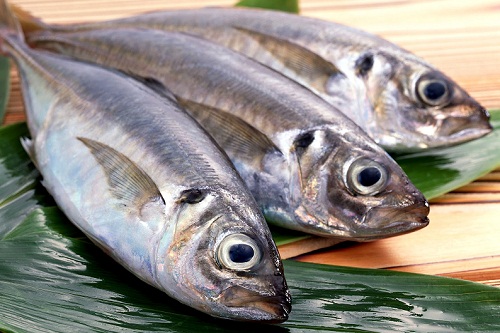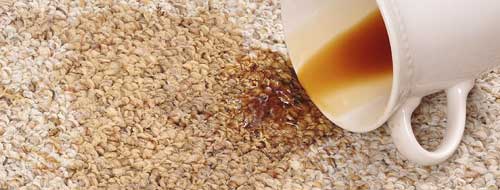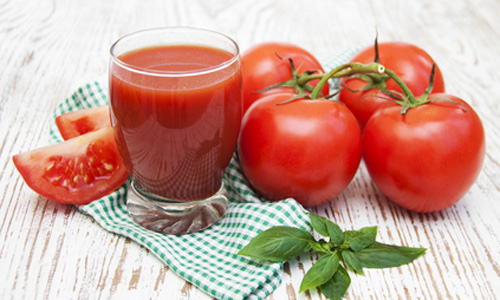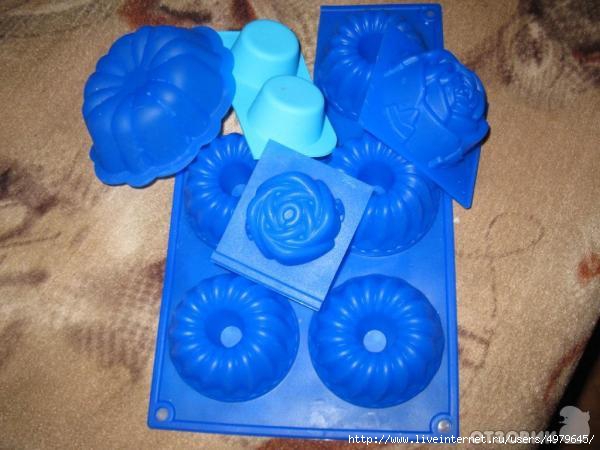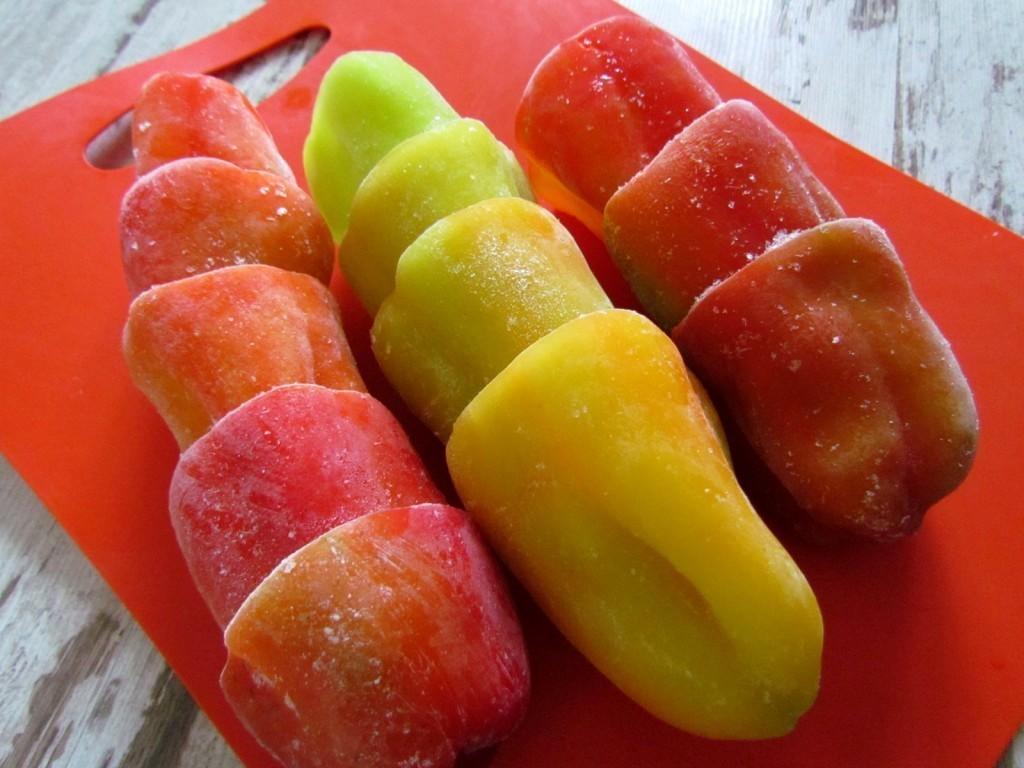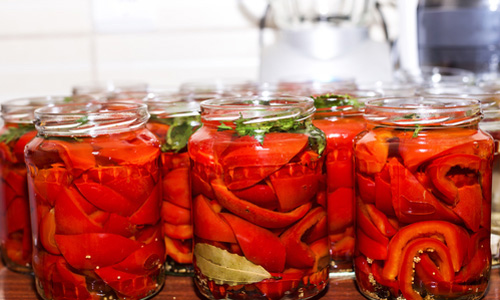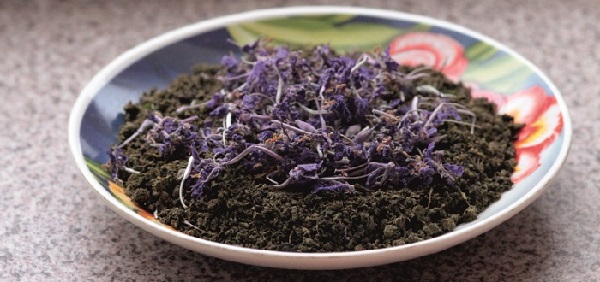The recipe for salting red fish at home in and without brine. In the kitchen, recipes - how to salt any fish
If you don’t trust shop delicacies, you should learn how to salt red fish yourself. For this, first of all, it is worth deciding on the type of fish: for salting, salmon and trout are considered more suitable. It is better to cook pink salmon with the addition of vegetable oil, and then marinate additionally.
Knowing how to salt red fish at home, you can cook a natural fresh product
Ingredients
Peppercorns 5 pieces Bay leaf 3 pieces) Sugar 1 tbsp Salt 1 tbsp Red fish 1 kg
- Servings Per Container:8
- Time for preparing:2 minutes
How to salt red fish at home
Use coarse salt, preferably sea salt. Fine salt salts out faster, but at the same time dehydrates the fish.
For salting, take a whole carcass, better chilled. When buying a frozen product, pay attention to the fins - if yellow fat accumulated there, it means that the fish was thawed and re-frozen. Also avoid the product in multilayer packaging that does not allow the carcass to be seen.
Before salting, cut the fish. For this, a sharpened knife of medium length and scissors. It is advisable to cut fish in rubber gloves.
First, cut off the head and tail fin, clean the scales and rinse the carcass with running water. Scissor all the fins. Then make a longitudinal incision on the back, along the entire ridge, then the same along the belly. Carefully separate the pulp from the bones - the result is two layers of fillet.
Combine salt and sugar and grate the fillet with this mixture. Sprinkle one part with pepper and place bay leaves on it. Cover with a second filet and wrap everything in gauze. Put the fish in a glass or ceramic container with a lid and refrigerate for 2 days.
If desired, add spices and herbs to your liking.
Knowing how to salt red fish at home in a dry way, you can always have a healthy and natural snack on hand.
Salmon of pink salmon in mustard marinade
To do this, take:
- pink salmon - 1 kg .;
- salt - 3 tbsp. l .;
- onions - 500 g;
- mustard - 3 tbsp. l .;
- water - 1 l.
Salmon cut into fillets, salt and leave in a container under pressure in the refrigerator for about 1-1.5 days.
Cut salted fillet into strips about 1-2 cm, chop onion rings. Take a glass jar and put the products there, alternating them in layers. Dilute the prepared mustard in the water and fill the fish with this mixture. Refrigerate for a day. After that, you can eat the dish as food.
Such fish can be used not only in classic sandwiches, but also as a filling for pancakes, as well as as a component of salads. Instead of butter, you can spread cottage cheese or cream cheese on sandwiches. If there is caviar in the fish, then it is salted in the same way.
For salting fish at home, we need:
A wooden box or an enameled pan (to fit a fish into it). Coarse salt. Fine salt "Extra", for salting fish not suitable. River or lake fish (small and medium-sized) bream, carp, crucian carp, cheshon, bream, etc.
We wash the fish with cold running water. Bowel fish before pickling not necessary. Pour a layer of salt about 0.5 cm onto the bottom of a wooden box (or enameled pan). Lay one layer of fish on top of it, pour a layer of 0.5 cm of salt on top. After that, lay a second fish layer and fall asleep again salt etc.
When all the fish is completely packed, we fill up the last layer of salt and put a load on the fish. You can use a smaller lid or a plate and a 3-liter jar of water (as a load). After that fish need to put to saline in a cool place, if possible in the refrigerator for 4 - 5 days. After this time, fish from brine we take out and rinse with running water from the salt and put it again in a clean saucepan. Fill in fish fresh water so that excess salt comes out of it. In numerical water salted fish leave for 1 hour.
Then we take the fish out of the water and lay it on a paper towel so that it dries out a little. After that we hang each fish (by the eyes or by a hook on the lip) dry. Leave fish to dry for 5 to 10 days. Duration drying (drying) fish Depends on ambient temperature and fish size.
Before gathering my courage and salting red fish at home for the first time, I decided to prepare thoroughly. I read recipes with curiosity, “picked up saliva”, looking at mouth-watering photos on the Web and cookbooks ... I was very afraid to spoil a delicate and rather expensive product. But my fears seemed to be in vain. I successfully went to the market, chose a beautiful fat little “victim” of my culinary experiments. And the good seller immediately removed her ridge with a huge and dangerously sharp knife. I did everything according to the instructions of experienced cooks and in the morning I treated my husband with deliciously salted salmon. He praised me, and I, rosy-red with delight, graciously accepted compliments. Everything went almost perfectly. Until that moment, when I had lunch, I looked into the kitchen and saw a lonely vessel with a fish on the table. I, a muddler, forgot to hide him in the refrigerator. Having read that the snack may disappear, I still regretted throwing it away. After all, there remained 800 grams, no less. But I was afraid to feed loved ones. So there was a rosy potato and fish pie, the need for which is still a mystery to her husband. But this is another culinary story, I will tell about it later. And now - proven photo recipes of delicious red fish.
How to simply pickle red fish at home
Let's start with the basic method. Nothing extra! No flavoring seasonings! Salt, fish and a pinch of sugar. The taste is amazingly natural, delicate, and the appetizer itself seems to melt in your mouth. Ideal for salmon or trout salting.
Essential Ingredients:
How to simply pickle red fish (recipe with photo):
|
This time I managed to snatch a whole (albeit a small) carcass of rainbow trout. But usually I don’t hesitate to pickle frozen steaks. And I don’t disdain even belly. So you can use any edible part. Defrost the main ingredient at room temperature or in salted cold water. If you have an undivided fish, like mine, or a piece with a skin, remove the scales. Then, if necessary, cut off the head and tail. You can also get rid of fins. Take out and discard the insides, open the abdomen. It is advisable to work with a sharp knife with a thin flexible blade. Wash well. |
 |
|
Now make the filet. Carefully cut the ridge. Remove the bones remaining in the fish pieces with tweezers or hands. Rinse again. Blot with paper towels. Do not remove the skin. |
 |
|
Prepare a mixture for salting. Simply add salt to sugar (or vice versa) and mix. Why is granulated sugar needed? It acts as a natural preservative. On the palatability of salted red fish, its addition will practically not be reflected. But it will be stored longer. The same goes for lemon fresh. This is a preservative (a terrible word), but completely harmless. In addition, it eliminates a specific smell. Juice can be added to a ready-made treat before serving or during salting. Salt is better to take sea. The product will take it exactly as much as needed. Therefore, there will be no salting. But if it is not, ordinary coarse salt is also suitable. It needs less, pay attention to this. |
 |
|
Grate fillet (steaks) or sprinkle red fish belly with salting mixture, as in the photo. Put in a glass or plastic container (jar, another container) close to each other with the skin out. Cover or tighten with foil. Put in a cold place. In a day you will get a slightly salted fish. Do you like a brighter taste? Wait 36-48 hours. Look in the container once every 12 hours. Is a lot of fluid forming? Drain it. Decided to take chum or pink salmon as the main object? It may turn out to be rather dry. Therefore, I recommend salting it with vegetable (olive or deodorized sunflower oil) oil. Or pour them a ready-made dish for storage. |
 |
|
You will get a fragrant, delicate, mouth-watering and healthy snack. No other is given. And with it you can do anything you like: make sandwiches, twist rolls, cut salads ... Or just cut it, put it on a plate with translucent lemon slices and enjoy the incomparable treat. |
 |
How to savoryly pickle steaks or red fish fillets
A recipe for those chefs and connoisseurs of good food who love the zest. Of course, this is not about dried grapes, but about special accents that give seasonings. Follow the step by step instructions to get a spicy and original goodies!
Product Set:
Step by step recipe with photo:
|
This time I salted a salmon steak. It is not as saturated-bright in color as trout, especially after freezing-defrosting. But also delicious. Moreover, this method, although not much different from the previous one, involves the use of seasoning. And they will make their fragrant adjustments in the flavor bouquet of the finished snack. In general, let's go. Leave the fish at room temperature to thaw. You can even not completely defrost, so that beautiful pieces do not deform. Clean the scales. But leave the skin. Bones can be removed or left as desired. I cut the remains of the ridge, so I got two scooped fillets. |
 |
|
The composition of the dry pickling mixture includes sugar, salt and spices. What seasonings to use, decide for yourself. I’ll just leave here a list of aromas that combine with the fish, and you choose your favorites. To make the taste of red fish salted at home more interesting, you can add: coarsely ground black pepper, bay leaf, rosemary, thyme, basil, fennel, lemon juice, coriander, citrus zest. Naturally, all of the above should not be used. And in general, you should not overdo it with additives, otherwise spoil the dish. |
 |
|
Rub the red fish, dried up with paper towels, with a mixture and put in a container in which you will pickle it. Close the container tightly. Refrigerate for 24-48 hours (depending on the thickness of the pieces and the desired degree of salinity). |
 |
|
After 12 hours, check the fish. A lot of liquid will stand out - be sure to drain it. When the salting process is over, rinse the fish pieces in water and pat dry. You can store in the same container. Low-fat varieties (coho salmon, chum salmon, pink salmon) can be poured or greased with vegetable oil to boil more gently. I round off everything, I turn off the recipe, but leave a photo of salted red fish at home. And how to submit it and with what, decide for yourself. |
 |
Wet method of salting red fish
This option captivates with its simplicity and practicality. Even low-fat species will be juicy and tender thanks to a pickle with fragrant bay leaves and spicy pepper. And complementing the dish with onions and olive oil, you will prepare a real flavor bomb. I warn you, do not swallow the tongue when you try it!
What is required:
Cooking method:
|
If the product is frozen (as in my case), defrost it. But not completely, for the convenience of cutting. Clean the scales. Butcher the whole fish on the fillet. You can leave the steak whole. Then rinse well and pat dry with thick paper towels. |
 |
|
Cook the brine. Mix salt and spices. set on medium heat and bring to a boil. remove from the stove and cool completely. Then pour in apple cider vinegar or lemon juice. |
 |
|
Place in a bowl (made of food-grade plastic, glass, ceramic or enameled metal). Gently pour in the brine. Cover tightly. Put in a cold place. To slightly salinize red fish at home, a day will be enough. For a stronger ambassador, it will take a little more - 36-48 hours. Cut the finished fish appetizer into small pieces and place in a jar or pans. Alternate between slices with thin onion rings. Pour in vegetable oil (odorless sunflower or olive). |
 |
|
Store in a cool place for 3-4 days. From juicy tender fish you can prepare sandwiches for breakfast or a snack and other delicious dishes. |
 |
- To speed up readiness, you can put oppression. To do this, put it in a bowl. Cover with a flat plate. Place a load, such as a jar or bottle of water, on top.
- It is not advisable to give slightly salted fish to small children, this can lead to poisoning. For a children's menu, an appetizer will be suitable after at least two to three days of spilling.
- When choosing a chilled product for salting, make sure that there are no stains and an unpleasant smell of decomposition on it.
- To get spicy, you can add a little garlic and dried dill.
- Refrain from using microwave and hot water when defrosting the main ingredient. This will certainly affect the taste of the finished dish.
- Serve as a filling for pancakes, tartlets or canapes, make sandwiches or serve on a plate as a beautiful and tasty fish cut with fresh herbs, lemon and vegetables.
Enjoy and healthy fish appetite!
In contact with
Classmates
In stores today you can find slightly salted fish in a large assortment, but we can not always be sure of its quality. Preservatives and other unhealthy food additives are often used. Therefore, knowledge of how to salt fish at home is necessary for those who love fish, but want to be sure of the quality of the products on their table.
The main methods of salting fish at home
 There are two main methods of salting fish: dry and marinade. The first involves rubbing the fish fillet with a salt-based mixture, the second involves placing pieces of fish for a certain time in the marinade.
There are two main methods of salting fish: dry and marinade. The first involves rubbing the fish fillet with a salt-based mixture, the second involves placing pieces of fish for a certain time in the marinade.
You can salt both fresh and frozen fish. Moreover, in the second case, as a rule, it is not recommended to defrost it first. Although there is no unanimous opinion on this matter among home cooks.
Almost any fish is salted. However, most often, at home, salted herring, mackerel, horse mackerel, pink salmon, chum salmon, trout, a little less often - salmon and other fish.
We suggest that you familiarize yourself with the main methods of salting fish at home in more detail.
Salting frozen fish
In order to salt frozen fish, it must first be chopped: you only need fillets. In varieties of fish with tender flesh, the fillet is left with the skin, and in hake, horse mackerel and other fish with dense pulp, the fillet is taken without skin. River fish are usually not suitable for this.
The prepared fillet is coated with olive oil, sprinkled with onion rings and thin cloves of garlic and put in the refrigerator for a day, after which it is considered ready. For a kilogram of fillet, two to three onions and two cloves of garlic, as well as a tablespoon of oil, will be required.
For those who are confused by the lack of salt in the recipe, you can offer another recipe, more common.
 Ingredients required:
Ingredients required:
- fish fillet - kilogram,
- granulated sugar - half a teaspoon,
- olive oil - a tablespoon.
Cooking process:
- Fill the fish fillet (frozen) with a thin layer of olive oil, let it lie down for at least 10 minutes.
- Combine coarse salt (fine for salting fish is not good) and sugar.
- Spread each piece of fish pulp with the mixture.
- Fold in a plate, cover with another plate a little smaller, put a container of water on top to create a slight pressure.
- Put the fish in the refrigerator for a day. In a day, it can be used to make sandwiches, cut into thin slices.
Dry red fish ambassador
 Ingredients required:
Ingredients required:
- red (fillet) - kilogram,
- coarse salt - 2 tablespoons,
- granulated sugar - a tablespoon,
- dill - to taste,
- ground pepper - optional.
Cooking process:
- Prepare the fillet.
- Mix salt and sugar, rub them with each piece.
- Put half of the fish on a parchment in one layer.
- Sprinkle, if desired, with a small amount of pepper, put dill branches on top.
- Spread the remaining filet in a second layer.
- Cover with parchment.
- Wrap everything together in baking paper and place in a cold place (such as a refrigerator). The fish should salt under a little oppression.
- Serve a red fish salted in this way to the table the very next day.
Dry strips of herring
 Ingredients required:
Ingredients required:
- - one kilogram,
- salt - two tablespoons (with peas),
- dill seeds - a teaspoon,
- coriander - half a teaspoon,
- allspice peas - 5 pieces.
Cooking process:
- Fold the same size of herring carcass (unfinished, with intact skin) in an enameled container.
- Sprinkle salt, dill, coriander on top, put pepper, roll the fish in salt and spices on all sides.
- Put in the cold (the optimum temperature is about zero degrees).
- Salting time depends on the size of the fish: large salts longer. Usually enough for three to four days. In the same exact way, you can salt the mackerel, but to make it salted, it takes more time.
Pickling herring in a marinade
 Ingredients required:
Ingredients required:
- herring (unfinished) - kilogram,
- vinegar - half a cup,
- water - two glasses,
- onions - a pair of heads,
- salt - a tablespoon.
Cooking method:
- Peel the herring from the insides, cut into pieces, cut each piece in half. If not laziness, then previously herring can be stoned - so it will be much more pleasant.
- Prepare the brine by mixing and boiling water, vinegar and salt.
- Cut into thin rings or half rings of onions.
- Put the pieces of herring in a ceramic bowl (a plate is also suitable), put the onion on top, pour everything with marinade and put in a cold place. Two days later, the herring is ready.
Salting river fish
 River fish is usually salted in a dry way. Previously, it is usually gutted and gills removed. Small fish can not be gutted.
River fish is usually salted in a dry way. Previously, it is usually gutted and gills removed. Small fish can not be gutted.
The second step is to sprinkle the fish with salt on all sides. Salt is also poured inside. Then lay in layers in an enameled pan or basin, pouring salt over each layer. Typically, five kilograms of fish takes almost a kilogram of salt. Two weeks is usually enough to make the fish salted. A small fish will salt out twice as fast. Salted river fish can be stored all winter.
In contact with
It happens that in the hot season it is urgent to save fish. The best way to save for future use when fishing or at home is salting. How to salt a river fish? Let's look at some recipes for preparing roach, perch, gobies, bleak and roach large, medium and small.
Types and methods of salting river fish
It is hard to imagine real Russian cuisine without river fish. A resident of the rivers is good in ear and other fish soups, she is boiled in water, steamed, dried, dried and salted. If large freshwater inhabitants can be cleaned, cut and salted in pieces, then smaller bony specimens are better prepared using whole salt.
Attention! For salting any fish, only coarse salt is suitable. Only she, slowly dissolving, gradually pulls liquid out of the fish. Finely ground salt will only saline, but not dry, river fish.
The principle of the ambassador is simple: salt does not preserve, it simply removes moisture from the fish. The salting of a river dweller is wet, dry, mixed and sagging.

What is brine?
The wet method of salting freshwater inhabitants is inextricably linked to one interesting concept, brine. In other methods of preparation, this definition is not used.
Tuzluk is the moisture released by the fish during salt treatment. A special liquid is saturated with proteins, minerals and even the most valuable fish oil, which is why it differs from ordinary brine and has its own name.
In fact, fish salted in a wet or dry way is cooked exactly the same. The fundamental difference is that the brine stays in the tank or flows (is removed) from there.
Wet version of salted roach, perch, gobies, bleak and roach with sugar
This method is suitable for both hiking and home. Freshwater cooked with added sugar have a more refined, more delicate taste. To prepare fish in this way, it is better to follow a step by step recipe:
- Prepare a non-oxidizing container, such as a bucket or pan.
- Clean the fish carcasses, leaving your head. Remove the scales.
- The first layer of the catch should be laid directly at the bottom of the container. Carcasses should be placed upside down.
- Pour each instance with salt in a proportion of 10 kg. fish and 1 kg. coarse salt plus 1 tbsp. l Sahara.
- Layers of fish alternating with salt should not reach the top of the tank. A press should be placed on top of the fish mass.
- After 2 days, the brine will cover the entire mass.
- After 3 days, small fish will be ready, and after 7-8 days - large. The finished batch is pulled out of the brine, washed under running water and left to dry in the open air. Then roach, perch, gobies, bleak or roach can be folded for long-term storage in any containers.

Small fish salt for three days, large - 5-7 days
Tip. The role of the press can be played by an ordinary large plate, covered with something heavy. However, experienced fishermen are advised to put together a special wooden circle. The best material for its manufacture is linden or aspen. Only this wood does not emit harmful substances into the brine and does not deform under its influence. In no case should you make a press of plywood! It can exfoliate and release glue residues into the fish.
Quick dry ambassador of large river catch
If you decide to salt large individuals (from 0.5 to 1.5 -2 kg.), Then you can not only clean them, but also dissolve along the back, remove the ridge, head and tail. Scale - do not touch!
- Dry the processed carcass. In this case, each copy will look like an expanded book, with its open belly up.
- Rub salt on the fish from the side of the scales and lay them in even layers in a wooden box, sprinkling salt on each layer. The largest carcasses should be at the bottom.
- If you decide to leave your heads, then you need to lay out the fish in a checkerboard pattern. For example, the first layer with your heads to the left, the second - with your heads to the right. Thus, oppression will put pressure on the entire mass evenly.
- For the whole batch, put wooden oppression and put the box on a pallet in a cool room. If possible, the container can be placed directly on the ground or in a small hole. The brine will drain down through slots in the tank.
With this cooking option, fish weighing about 500 grams. can be tried in 3 days. And for a solid salt of a large catch weighing about 1.5-2 kg., It will take 10 days.

Ambassador wobble without sugar. Wet and dry way
Vobla is a fairly common inhabitant of Russian rivers. Often, fishermen, having caught this fish, ask the hostesses the difficult task of processing it. In fact, the recipe for the proper preparation of roach, like any other freshwater fish, is quite simple:
- medium or large fish need to be gutted and the scales removed. Then rinse and dry the carcasses;
- the next step is rubbing the roach with salt. Salt is laid not only outside, but also inside the abdomen of each specimen;
- grated fish should be laid in rows in any dish that is convenient for you and wait only 5 days.
If you planned a wet ambassador, then the fish must be crushed by oppression and left in a container. Gradually, the carcasses will release fluid, this is brine.
For dry salting, you need to lay the catch as described in the recipe, but the container for salting should be with holes. A brine will leak through them, and the roach will remain dry.
Sagging method of salting roach, bleak and other river fish
This recipe is best used for oily, tender fish. The advantage of the method is that freshwater meat is more tender and differs in taste from traditional salted fish. The downside is the need to build a special construction for salting.

Stages of cooking:
- Install containers for harvesting fish so that it is possible to hang and strengthen a number of transverse rods of the same length on it.
- Suspend whole (if small) or gutted individuals on rods so that there is a small distance between the carcasses. Fish should be fully lowered into the tank.
- In a plastic basin or other container, it is necessary to fill the prepared brine. To do this, dissolve the salt in water.
- If water and salt completely covers the catch, then everything was done correctly.
Tip. How to determine the right amount of salt in brine? Very simple! If you drop raw potatoes or eggs, they should not sink, but swim on the surface.
After 5-7 days, a salt batch can be eaten. But before that, it should be removed from the liquid and dried a little.
The above methods of brine are well used to save for the future a large catch. Regardless of the recipe, roach, perch, gobies, bleak or roach can be stored for a long time, or eat immediately after the end of the ambassador. And you can soak 3-4 hours in water or milk and use for frying or cooking a variety of fish dishes.
Salting river fish - video
River fish ambassador - photo










